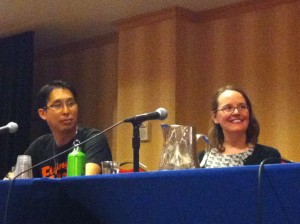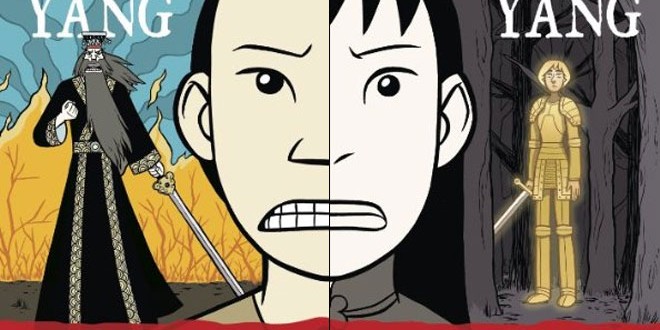By Jenny Chen
When Gene Yang was a child, he would sneak to the local comic book store in Cupertino, Ca. by asking his mother to drop him off at the library, walking 10 minutes to the comic book store, and then hiding his comic books in huge tomes from the library so that his mother would never suspect that he was consuming less than serious reading material.
Today, Yang is one of the most successful graphic novelists of his time. His book, American Born Chinese won the 2006 Michael J. Printz award, which is awarded by the American Library Association for “the best book written for teens based entirely on its literary merit”, and the Eisner award for the best new graphic album.
On Saturday, September 14, Yang joined fellow graphic novelist Raina Telgemeier, author of Smile, at the Small Press Expo in Bethesda, Md. to promote his latest book, Boxers and Saints, and to answer questions from his fans.
Boxers and Saints uses magical realism to convey both sides of the Boxer Rebellion, a controversial time in Chinese history when proto-nationalist Chinese martial arts fighters (they called themselves the Society of Righteous and Harmonious Fists) sought to drive out Christian missionaries and other Western influences. The rebellion took place after the country had been ravaged by the Opium War.
The first installment of Yang’s diptych, titled Boxers, follows the the story of Little Bao, a Chinese boy who is involved with fighting the Christian missionaries. Saints, follows the story of Four-Girl as she finds refuge in the Christian church.
Yang told audiences on Saturday that Boxers and Saints was difficult to do in part because of the balance he had to strike with graphic violence. “It’s definitely the most violent thing I’ve done…some of the photos I saw while doing research were really graphic and because I was working in this graphic medium, I had to be portray some of that in order to be true to the subject,” he said.
Yang also said he was working on a superhero graphic novel that tells the story of the first Asian American superhero during the “Golden Age” of superheroes – the Green Turtle. Story has it, Yang said, that the author of the Green Turtle series (Chu Hing) wanted the superhero to be Chinese American but his publisher would not allow it so the Green Turtle was always drawn with his face in shadow or covered so that the author could continue to believe that his character was Chinese American. In his latest work, Yang is telling the story of the Green Turtle, in “The Shadow Hero” and giving him the face time he never had during his original run. Singaporean artist Sonny Liew is illustrating it.
When asked about his status as an Asian American graphic novelist, Yang said “Comics have traditionally been an outsider’s medium…they may not find a voice anywhere else but comics don’t have a lot of gatekeepers, not a lot of barriers to entry. That’s why you see a lot of Asian Americans involved in comics.”

 Asian Fortune Your source for all things Asian American
Asian Fortune Your source for all things Asian American
